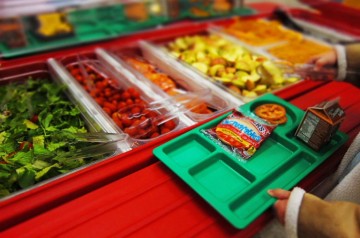Oregon School Meals Receive Mixed Reviews in Yearly Report Card
Thursday, October 15, 2015

Oregon was given an “outstanding” rating in four areas, a “satisfactory” rating in another four areas and an “in need of improvement” rating for three. It received high scores for offering all school districts in the state access to additional funding for healthy meals and offering free breakfast at 95 percent of schools.
Not Taking Advantage
Oregon also scored high marks for increasing funding for its Farm to School Programs and increasing access to free meals.
Earlier this year, the State Legislature provided more than $4.5 million in grants to Farm to School programs. The program helps schools provide fresh and local meals to students. The State now also covers free meals for more than 30,000 students from low-income families.
However, the report said that not all students eligible for free and reduced-price meals take advantage of the program. Only 37 percent of eligible student eat free breakfast, a level that was marked for improvement in the report. 66 percent eligible students of eat school lunch each day, enough to earn the state a “satisfactory rating.”

That may soon change, thanks to a federal program that allows schools with many low-income students to provide free meals to all students at the school, minimizing the stigma associated with it. Schools will also now be able to offer “breakfast after the bell” allowing impoverished students who cannot get to school early enough to have breakfast before school starts time to eat their first meal after the school day begins.
Room for Improvement
The availability of fresh water at schools in Oregon needs to improve, according to the report.
Despite water ranking as the healthiest of beverage options, the report found that schools needed to do a better job of offering it to students. Many school buildings have not updated their water fountains since classes first began, and others are not clean or inviting.
The report also found that schools need to limit marketing for junk and snack foods. While Oregon received a satisfactory rating for keeping unhealthy foods away from students while they are in school, they were rebuked for allowing too much advertising and marketing from junk food companies on vending machines and in advertisements at gyms and schools.
Related Slideshow: Mum’s the Word: Parenting in Sickness and in Health
Related Articles
- Scott Taylor: Sick of Portland Street Kids Getting a Free Lunch
- World AIDS Day Luncheon at Nines Honored Heroes of HIV
- Party Report: Equity Foundation’s Women Who Lead Luncheon
- Party Report: Albertina Kerr Community Awards Luncheon With Storm Large
- Oregonians Against Discrimination: Business Leaders Luncheon at OCC
- Cheryl Strayed to be Keynote Speaker at Community Awards Luncheon
- Oregon Health & Science University Arms Campus Cops
- Oregon Nursing Homes With the Most Health and Safety Deficiencies
- Oregonians Rank Best and Worst Healthcare Providers
- Restaurants Violate Health Code Four Times More Often Than Food Carts
- Oregon Bill Takes Big Step in Women’s Reproductive Health
- New Bills Highlight Holes in Oregon’s Mental Health Care
- Number of Oregonians Without Health Insurance Falls by 63 Percent
- Rules Change Could Lead to Spike in Health Advisories at Oregon Beaches
- Rules for Eating Healthy On a Budget
- The 14 Biggest Health Stories of 2014
- The Health Benefits of Walking
- ZOOM+Smile On-Demand Dental Health Care Opens in SE Portland
- Ten Tips For A Healthy Thanksgiving Day
- Survey Finds Few People Know How to Maintain a Healthy Brain
- School Bugs: 5 Ways to Boost Your Family’s Health During the School Year
- Second Texas Healthcare Worker Tests Positive for Ebola
- Super Bowl XLIX: Using Hate To Heal A Nation
- Mum’s the Word: Parenting in Sickness and in Health
- Is Detoxing Actually Healthy for You?
- Armed School Guards Lack Mental Health Screening
- BurnCycle Fosters Good Health Through Local Partnerships
- BuzzFeed Claims Monica Wehby Plagiarized Health Plan
- By The Numbers: How Oregonians Rate Their Healthcare Providers
- Are Babies Healthier in Neighborhoods With More Trees?
- App-Tastic: The 7 Best Health and Fitness Apps
- 6 Things to Know About Healthcare.gov Enrollment in Oregon
- 69,000 Oregonians Hit by Health Data Breaches
- Animal Shelter Struggles With ‘Unhealthy and Untreatable’ Pets
- Children’s Healing Art Project Director Steps Down
- Eat This, Not That: Healthy Thanksgiving Food Swaps
- Health Goth: New Lifestyle Trend Created in PDX
- How A Portland Acupuncture Business is Seeking to Change the Face of Health
- How Should the Portland Timbers Use a Healthy Diego Valeri?
- Health Care is More Than Medical Care
- Four Steps to Creating a Healthy Lifestyle
- Eat Well, Heal Fast: A Guide to Nutrition for Bikers
- Evolution Healthcare & Fitness Grand Opening
- Five Ways Living in the Moment will Improve your Health
- 6 Make-Ahead Healthy Breakfasts to Start the School Day Right












Follow us on Pinterest Google + Facebook Twitter See It Read It